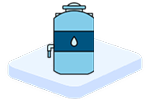



Fracturing fluids and well stimulation are most commonly aqueous systems comprising various polymers and crosslinking agents added to facilitate effective proppant transport and placement. A goal of fracturing practitioners has been to apply breaker technologies effective to eliminate or minimize the residual gel damage left behind by such systems in order to optimize the well stimulation.
With the development of specific-enzyme breaker that are able to cleave a specific type of linkage on different types of polymer it became possible to target individual polymer groups with individual enzymes for complete degradation. These enzymes break the critical linkage sites by catalytic process and produce simple sugar fragments which are soluble in aqueous fluids and result non-damaging towards the reservoir.
Previous field observations showed that the wells used the enzyme breaker can get better production compared with the wells used conventional breaker according to long-term production data analysis from 170 fracture stimulated wells. The possible reason is that the enzyme breaker has better performance on the gel breaking, and thus , it can ensure an effective flowback which can reduce the damage of the fracturing fluid to formation permeability and enhance the CBM production.

We make essential innovations the world needs now, Bioremediation cleans up the environment naturally without the use of toxic chemicals. So, it is an environmentally friendly method. Bioremediation is a unique technique for cleaning the environment. In this technique, microbes or plants are used to detoxify the contaminants in the soil, water, ant other environments, relies on stimulating the growth of certain microbes that use contaminants like oil, solvents, and pesticides as a source of food and energy.

Hydrogen Sulfide (H2S) is a toxic and odorous compound present in biogas produced by the anaerobic digestion of biosolids and other organic materials, Due to it’s corrosive nature in internal combustion engines, biological hydrogen sulfide removal processes are being investigated to overcome the chemical and disposal costs associated with existing chemically-based removal processes. Souring can be controlled by several technology and treatment program that we can suggest according the field case.